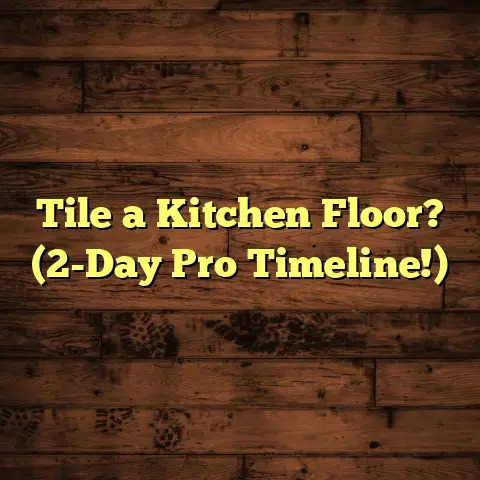How To Use A Hardwood Floor Nailer: A Step-by-step Guide?
I’ve seen firsthand how this tool can transform a daunting task into a smooth, efficient, and satisfying experience.
Forget the days of aching backs and inconsistent nail placement. Trust me, once you master the hardwood floor nailer, you’ll wonder how you ever lived without it!
Let’s dive into the hidden benefits and how this tool can elevate your next hardwood flooring project.
Introduction: Unleash the Power of the Hardwood Floor Nailer
Have you ever considered what truly separates a good hardwood floor installation from a great one?
It’s not just about the wood itself; it’s about the precision, the consistency, and the long-term durability of the installation.
That’s where the hardwood floor nailer comes in.
This isn’t just another tool; it’s an investment in quality and efficiency.
I’ve personally witnessed how using a nailer not only speeds up the installation process but also ensures a professional finish that stands the test of time.
Why choose a nailer over traditional methods?
Let me break it down for you:
- Reduced Physical Strain: Say goodbye to backaches and sore knees! The nailer does the heavy lifting, allowing you to focus on precise placement.
- Increased Accuracy: Consistent nail depth and angle mean a secure, squeak-free floor.
- Time Savings: What used to take days can now be accomplished in a fraction of the time.
- Professional Finish: The consistent, hidden nailing creates a seamless, aesthetically pleasing result.
In my experience, the difference between a hand-nailed floor and one installed with a nailer is night and day.
The nailer delivers a level of consistency and precision that’s simply impossible to achieve manually.
Ready to unlock the secrets of this amazing tool? Let’s get started!
Section 1: Understanding Hardwood Floor Nailers
1. Definition and Types of Hardwood Floor Nailers
So, what exactly is a hardwood floor nailer? Simply put, it’s a specialized tool designed to drive nails or staples at a precise angle through the tongue of a hardwood plank and into the subfloor.
This creates a secure, hidden fastening that allows the wood to expand and contract naturally without unsightly nail heads.
Now, let’s talk about the different types. I typically break them down into two main categories:
-
Manual Nailers: These require you to strike the nailer with a mallet, using your own force to drive the fastener. They’re generally more affordable but require more physical effort.
-
Pneumatic Nailers: These are powered by compressed air, offering greater speed and consistency. They’re my go-to choice for larger projects or when I want to minimize fatigue.
Here’s a quick comparison table:
| Feature | Manual Nailer | Pneumatic Nailer |
|---|---|---|
| Power Source | Manual Force | Compressed Air |
| Speed | Slower | Faster |
| Effort | More Physical Exertion | Less Physical Exertion |
| Consistency | Can Vary | More Consistent |
| Cost | Lower | Higher |
| Project Size | Smaller to Medium Projects | Medium to Large Projects |
I’ve used both types extensively, and while manual nailers can be a good option for small DIY projects, I find that the speed and consistency of a pneumatic nailer are well worth the investment, especially if you’re planning on doing a lot of flooring.
2. How a Hardwood Floor Nailer Works
Alright, let’s get a bit technical and peek under the hood.
The mechanics of a hardwood floor nailer are surprisingly simple, yet incredibly effective.
Whether it’s manual or pneumatic, the core function remains the same: to drive a fastener at a precise 45-degree angle through the tongue of the hardwood plank.
Here’s the breakdown:
- Positioning: The nailer sits on top of the plank, with the tongue nestled against a guide.
- Activation: For manual nailers, you strike the nailer head with a mallet. For pneumatic nailers, you apply pressure and trigger the firing mechanism.
- Driving: The force drives a nail or staple through the tongue and into the subfloor.
- Securing: The fastener is angled in such a way that it pulls the plank tight against the subfloor and the adjacent plank.
Types of Fasteners:
- Nails: Typically 16 or 18 gauge, these provide excellent holding power.
- Staples: Offer a wider grip but may not be suitable for all types of hardwood.
The choice between nails and staples often comes down to personal preference and the manufacturer’s recommendations for your specific flooring.
I generally prefer using nails for their superior holding power, but I always consult the flooring manufacturer’s guidelines to ensure the best results.
Important Note: Always use the correct type and size of fasteners recommended for your nailer and flooring.
Using the wrong fasteners can damage the nailer or compromise the integrity of your floor.
Section 2: Preparation for Using a Hardwood Floor Nailer
1. Gathering Materials and Tools
Okay, before we start hammering away, let’s make sure we have everything we need.
Here’s a checklist of essential materials and tools:
- Hardwood Floor Nailer: (Manual or Pneumatic)
- Nails or Staples: (Correct type and size for your nailer and flooring)
- Hardwood Flooring: (Acclimated to the room’s environment)
- Mallet: (For manual nailers)
- Air Compressor: (For pneumatic nailers, with appropriate PSI rating)
- Safety Glasses: (Protect your eyes!)
- Hearing Protection: (Especially important for pneumatic nailers)
- Knee Pads: (Your knees will thank you!)
- Moisture Meter: (To check subfloor moisture levels)
- Measuring Tape: (For accurate cuts and spacing)
- Chop Saw or Hand Saw: (For cutting planks)
- Pry Bar and Spacers: (For positioning and securing planks)
- Broom or Vacuum: (For cleaning the subfloor)
- Level: (To check the subfloor’s flatness)
I know it seems like a lot, but having everything on hand before you start will save you time and frustration in the long run.
2. Preparing the Workspace
Proper preparation is key to a successful flooring installation. Here’s what you need to do:
- Clear the Room: Remove all furniture and obstacles from the room.
- Clean the Subfloor: Sweep, vacuum, or even scrape the subfloor to remove any debris, dirt, or old adhesive.
-
Level the Subfloor: Use a level to check for any uneven areas. Minor imperfections can be filled with self-leveling compound. Significant dips or humps may require more extensive repairs.
-
Check Moisture Levels: Use a moisture meter to ensure the subfloor is within the acceptable moisture range for your hardwood flooring. Excessive moisture can lead to warping, cupping, or other problems.
-
Acclimate the Hardwood: This is crucial. Stack the hardwood planks in the room where they will be installed for at least 3-5 days (or as recommended by the manufacturer). This allows the wood to adjust to the room’s temperature and humidity, minimizing expansion and contraction issues after installation.
I can’t stress enough the importance of acclimation. I’ve seen too many flooring projects fail because this step was skipped.
3. Choosing the Right Nailer and Nails
Selecting the right nailer and nails is essential for a successful installation.
Here’s what to consider:
- Type of Hardwood: Different types of hardwood have different densities. Softer woods may require a lower pressure setting on your nailer, while harder woods may require a higher setting.
-
Flooring Thickness: The thickness of your flooring will determine the appropriate nail length. Consult the nailer manufacturer’s recommendations for the correct nail size.
-
Nailer Compatibility: Ensure that the nails or staples you choose are compatible with your nailer. Using the wrong fasteners can damage the tool or result in improper installation.
Here’s a general guideline for nail length:
| Flooring Thickness | Nail Length (Approximate) |
|---|---|
| 1/2″ | 1 1/4″ |
| 3/4″ | 1 1/2″ – 2″ |
Pro Tip: When in doubt, consult the flooring and nailer manufacturer’s recommendations. They’ll provide the most accurate guidance for your specific products.
Section 3: Step-by-Step Guide to Using a Hardwood Floor Nailer
Alright, let’s get down to the nitty-gritty. Here’s a step-by-step guide to using a hardwood floor nailer:
1. Step 1: Setting Up the Nailer
Before you start nailing, you need to adjust the nailer to ensure proper operation.
-
Adjust Depth Setting: This controls how far the nail is driven into the wood. Start with a medium setting and test it on a scrap piece of flooring. Adjust the depth until the nail is flush with the surface of the tongue, without damaging the wood.
-
Adjust Pressure (Pneumatic Nailers): The air pressure also affects the driving force. Start with a lower pressure setting (around 70-80 PSI) and gradually increase it until the nails are consistently driven to the correct depth.
-
Load the Fasteners: Follow the nailer’s instructions for loading nails or staples into the magazine.
Safety First: Always disconnect the air compressor (for pneumatic nailers) or remove the mallet (for manual nailers) before making any adjustments or loading fasteners.
2. Step 2: Starting the Installation
-
Lay the First Row: This is the most important row, as it sets the foundation for the entire floor. Use spacers along the wall to maintain a consistent expansion gap (typically 1/4″ to 3/8″).
-
Face Nail the First Row: Since you can’t use the nailer on the first row (due to the wall), you’ll need to face nail it. Pre-drill holes at an angle near the wall and use finishing nails to secure the planks. Countersink the nails and fill the holes with wood filler.
-
Align and Secure: Use a pry bar and spacers to ensure the first row is straight and tightly against the wall.
3. Step 3: Nailing the Planks
-
Position the Nailer: Place the nailer on the plank with the tongue nestled against the guide. Ensure the base of the nailer is flush with the surface of the flooring.
-
Angle and Technique: Maintain a consistent angle (usually 45 degrees) when firing the nailer. For manual nailers, strike the nailer head firmly with the mallet. For pneumatic nailers, apply pressure and trigger the firing mechanism.
-
Spacing: Follow the flooring manufacturer’s recommendations for nail spacing. A general guideline is to place nails every 6-8 inches along the length of the plank.
-
Stagger Joints: Stagger the end joints of the planks from row to row to create a more visually appealing and structurally sound floor. Aim for a minimum of 6 inches between end joints in adjacent rows.
Common Mistakes to Avoid:
- Overdriving Nails: This can damage the tongue of the plank and prevent proper engagement with the next row.
- Underdriving Nails: This can leave the nails protruding, creating an uneven surface.
- Nailing Too Close to the Ends: This can cause the wood to split.
4. Step 4: Dealing with Obstacles
- Corners: Use a miter saw to cut the planks to fit around corners.
- Doorways: Undercut the door jambs with a jamb saw to allow the flooring to slide underneath.
- Uneven Surfaces: Use shims to level any uneven areas in the subfloor.
5. Step 5: Finishing Touches
- Inspect the Work: Carefully inspect the entire floor for any gaps, protruding nails, or other imperfections.
- Clean Up: Remove all debris and dust from the floor.
- Install Baseboards and Moldings: This will cover the expansion gap and give the floor a finished look.
- Apply Finish or Sealants: If your flooring requires it, apply the appropriate finish or sealant according to the manufacturer’s instructions.
Section 4: Maintenance and Care for Hardwood Floors
1. Routine Maintenance
- Sweep or Vacuum Regularly: This will remove dirt and debris that can scratch the floor.
- Use a Damp Mop: Use a microfiber mop and a hardwood floor cleaner to clean the floor. Avoid using excessive water, as it can damage the wood.
- Protect Against Scratches: Use felt pads under furniture legs and avoid wearing shoes with hard heels on the floor.
- Control Humidity: Maintain a consistent humidity level in your home to prevent excessive expansion and contraction of the wood.
2. Addressing Common Issues
- Squeaks: Squeaks are often caused by loose nails or movement between the flooring and the subfloor. You can try to fix squeaks by driving additional nails into the affected area or by applying shims between the subfloor and the joists.
- Gaps: Gaps can occur due to changes in humidity or improper installation. Small gaps can often be filled with wood filler. Larger gaps may require replacing the affected planks.
- Cupping: Cupping is when the edges of the planks are higher than the center. This is usually caused by excessive moisture. To fix cupping, you need to address the moisture source and allow the floor to dry out.
Conclusion: Your Hardwood Flooring Journey Awaits
Congratulations! You’ve now armed yourself with the knowledge and skills to tackle your own hardwood flooring project using a nailer.
Remember, patience and attention to detail are key. Take your time, follow the steps carefully, and don’t be afraid to ask for help if you get stuck.
The satisfaction of installing your own hardwood floor is immense. Not only will you save money, but you’ll also gain a sense of accomplishment and pride in your home.
So, grab your nailer, gather your materials, and get ready to transform your space with the timeless beauty of hardwood flooring!
And remember, I’m always here to help. Feel free to reach out with any questions or challenges you encounter along the way. Happy flooring!





